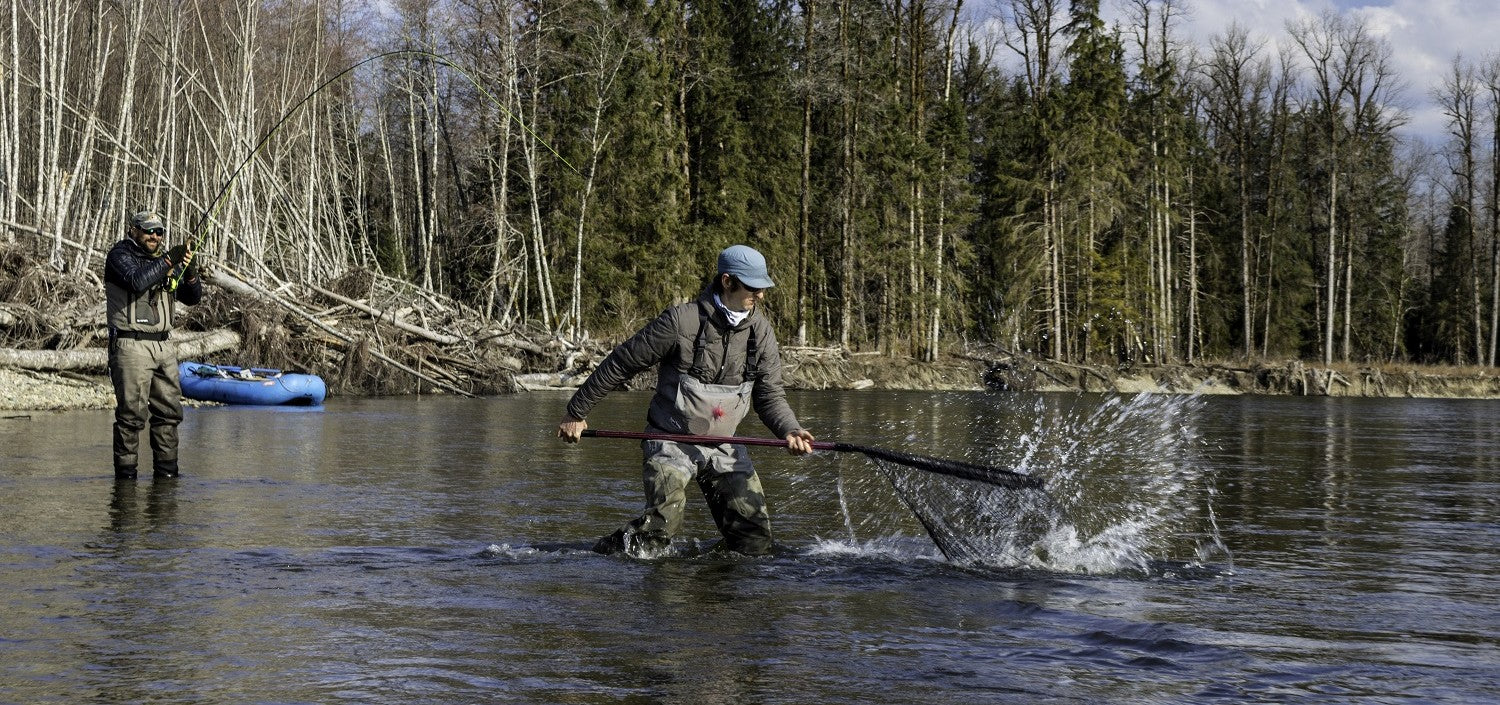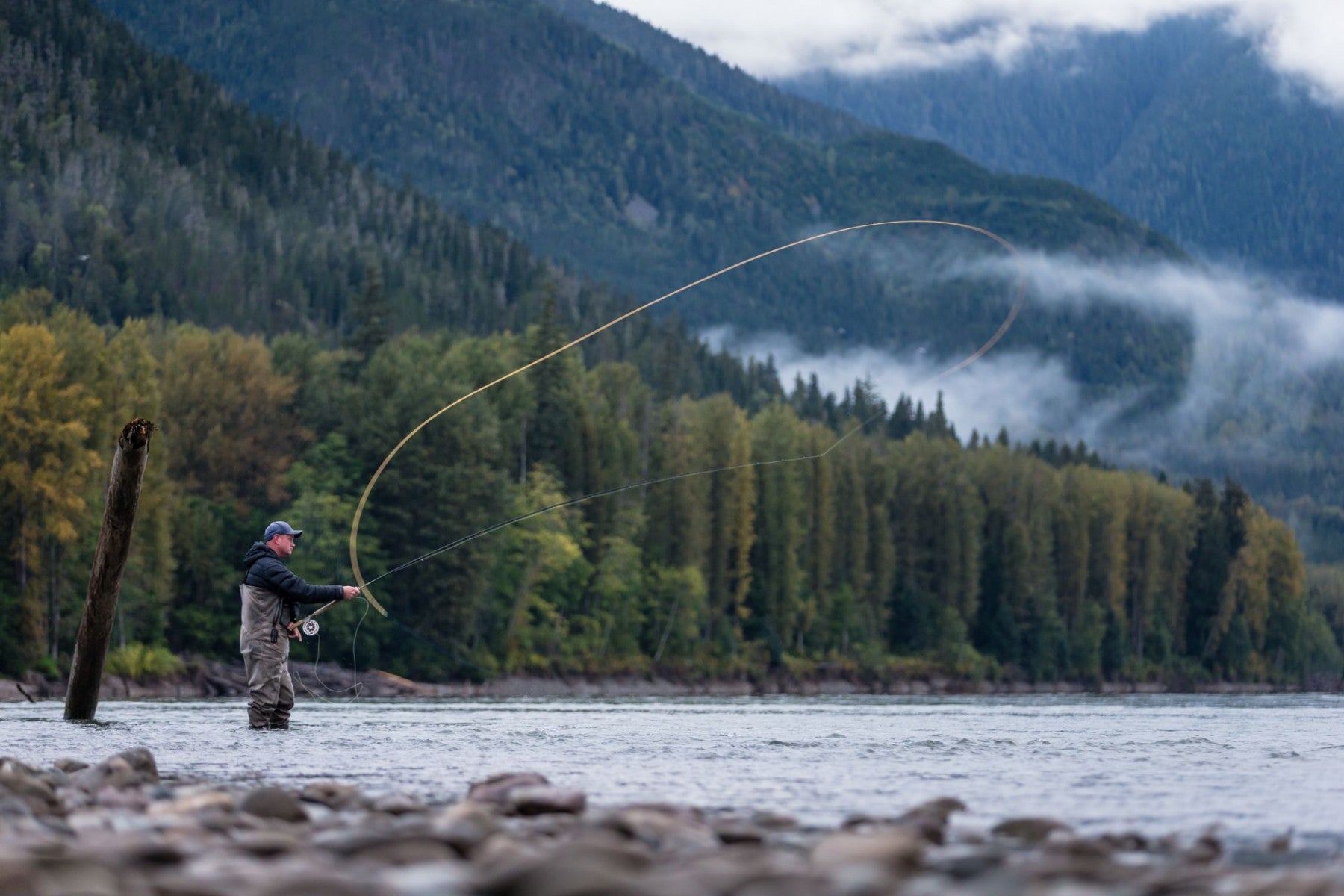British Columbia holds some of the finest freshwater fisheries in the world. Rivers such as the Skeena, Kalum, Copper, Kitimat, are world-class and continually produce some of the largest freshwater fish found on earth including steelhead.
Canada’s beautiful British Columbia is the western-most province and is bordered by the Pacific Ocean and parts of Alaska to the West, the Yukon and Northwest Territories to the North, and Montana, Idaho, and Washington to the South. The province is astoundingly big and is larger than any of the United States’ lower 48. Due to its proximity to the Pacific Ocean and its mountainous topography, B.C. has variable weather conditions throughout the year and can change at a moment’s notice. In the spring months of March, April, and the late summer and fall months of August – October the weather is manageable with steelhead in the system!

When steelheading in B.C. you want to make sure you are prepared. That means not only being prepared for variable weather systems with appropriate clothing but also making sure you bring the correct gear for the trip.
RODS For Steelhead
Your fly rod choice is the single most important piece of equipment to consider on your steelhead trip. We highly recommend that you test cast your rod and familiarize yourself with it before embarking on your trip. As far as single-handed or spey goes, both can be used.
Single-handed 9 – 10’ rods are extremely helpful for line control when making long casts and mending on a larger river. However, spey rods offer a definite advantage due to the fact that they allow you to make long casts with half the effort and allow long casts with very little or no back cast area. When picking out a two-handed rod 7 weight to 9 weight rods, in lengths of 12 ½ - 14 feet will suffice for B.C steelhead and can easily handle fish up to 20 + pounds. And if you do find yourself tied into a king, coho, or chum salmon these rods will do just fine.

REELS For Steelhead
We recommend a high-quality machined aluminum reel that has a smooth drag and a wide exposed rim for palming. Make sure that the drag system can operate well when wet as well as in the cold. Larger-sized reels, ones that can hold 150-250 yards of 30-pound backing in addition to your fly line are optimal.
We suggest using the Hatch 9 Plus Gen 2 Finatic for a reel that will hold up in tough conditions and will be able to handle big steelhead.
Steelhead LINES AND LEADERS
The line you choose is the second most critical piece of equipment that you need to bring. The line and leader system must be balanced in order to get the most out of your rod.
With everything working together simultaneously, many anglers prefer the “multi-tip systems” lines. This line system allows you to only carry one reel, a wallet, and the ability to not have to entirely re-string your rod when moving to a different piece of water or targeting a different species of fish.

Anglers will want to use floating lines with scandi heads for flies that sit on the surface or higher in the water column, and skagit lines for fishing a broad range of sink tips and larger heavier flies. Regardless of what you think may be correct, the weather will always dictate water conditions and river flows and in turn, your line and fly selection. Remember that the weather can change quickly so be sure to be prepared. Typically as a rule on most rivers, if the water is above 50 degrees and is clear, a floating line is perfect. In conditions with water temps below 50 degrees, or cloudy and off-color, a Skagit with a sink tip and a heavier fly should be used.
Selecting the right leader can be somewhat daunting if you don’t know where to start. Sink tip leaders for salmon and steelhead should be Segar blue label fluorocarbon and 3-5 feet in total length with a tippet strength of 15 – 20 pounds. And when fishing a floating line a long leader of 12 – 20 feet is recommended. Maxima Ultra Green is the choice for many guides and anglers.
You should also bring a variety of fluorocarbon and monofilament leaders when fishing for trout and char. Leaders ranging from 9-12 feet in length and 2x-5x are optimal. Steelhead dry fly leaders are simple. Start with 10-15 pounds of tapered Steelhead or Big Game leader (8 to 10 feet in length) with an additional 2 - 4 feet of 10-pound Maxima Ultra Green tippet. A stiff butt section of 2 feet of hard mono or hard mason in the 20 – 25 pound range is recommended and helpful for turning over long leaders and heavy flies.
Steelhead FLIES
Which correct fly to fish for any given time is a tricky question. Things change on a regular basis and having a good selection of steelhead flies in different sizes, colors, sink rates, and body profiles is important. The right fly is constantly changing throughout the day and throughout the season and sometimes within the same run! When choosing your flies for B.C., it’s virtually impossible to pre-purchase 100% of the “perfect flies” since the stream conditions and fish behaviors are always changing; and if you are fishing with a guide, they're going to have their standby! Whatever fly you are fishing, you must have confidence in it! The following are some flies to include in your steelhead fly box for British Columbia:
Hoh Bo Spey- Developed by Charles St. Pierre, the fly is hands-down our go-to on any steelhead river. Pack a few of these and prepare for the inevitable takes. With lots of movement in the water, these flies are irresistible to fish.
The Undertaker- Created by Wayne Duncan, the Undertaker is a staple in any steelheader's fly box.
Wake and Bake Black - For dry flies skating flies with big wakes is the name of the game. Pack a handful of Black and Purple Wake and Bakes and you'll be setting yourself up for success.
Popsicle (pictured below) - The Popsicle has been around since the 1980s, when young George Cook was guiding in the Bristol Bay region of Alaska, and it’s part of a group of patterns he created called the Alaskabou Series. Cook, who is now a well-known casting instructor and industry representative, used marabou as a base for the pattern and added some flash. The result is a gaudy fly that offers a lot of lifelike motion and plenty of flash in the water, and it has been catching steelhead and salmon for almost three decades.
Steelhead FISHING EXPECTATIONS
The one word that’s never been used to describe steelhead fishing is, easy. Regardless of how much time you spend on a trip, nothing is guaranteed when it comes to hooking and landing fish. Steelhead by their nature are very spooky, hyper-alert fish, and fooling them takes the utmost skill. There’s a reason it’s considered the “fish of a thousand casts” and every fish you catch is a special one. Whether it be your first small steelie or a 43-inch trophy, take a moment to appreciate the fish that comes your way. Trust us, your guide wants you to catch a fish just as much, if not more than you do.
But remember that even at the end of the day sometimes the stars just don’t align. But a day on the water is always a good day on the water, regardless of the fishing.
British Columbia Steelhead RIVERS
There’s a good reason why B.C. is considered the steelhead capital of the world: the amount of fishable water is seemingly endless. However, there are three main rivers that should definitely be on every steelheader’s list.

The Skeena River: This river and its tributaries are famous for winter steelhead. The famous river forms in northwestern British Columbia on the southern end of the Spatsizi Plateau and flows 350 miles before it meets up with the Chatham Sound and subsequently the Pacific Ocean. The Skeena, along with its tributaries like the Kalum, Kitimat and the Copper Rivers make your winter steelhead fishing opportunities almost endless.
Kalum River: The Kalum River is known for producing large steelhead. Steelhead can be found in the river year-round but they are especially prominent during the early spring months of April through May and then from August through October. This is a mid-sized river with a gravel bottom.
Kitimat River: Originating on the northern slopes of Atna Peak from glacial water, the Kitimat River provided the perfect habitat for big healthy steelhead returning to the freshwater. As one of the more accessible rivers, the Kitimat offers convenience on a world-class river. This river has long broad runs as well as numerous buckets that hold fish.
The Copper River: The Copper River is located right outside Terrace British Columbia. The Copper River is famous within steelhead circles and rightfully so. Similar to a handful of other rivers in the area, the Copper is can be very good dry fly fishing for steelhead. The Copper is riddled with great runs and productive riffles. Cast downstream and let the drag carry your fly across the river or feel free to fish dry flies upstream.
LODGING For British Columbia Steelhead
We work with five different operations in British Columbia all of which offer great accommodations and teams of professional guides. The seasons are short and the fishery in high demand so we strongly recommend looking at dates exactly 1 year in advance. Most of the lodged do give first right of refusal to book the same dates for the following year. Target months for steelhead are March, April and early May for winter-run fish and then August – November for the summer run.
Nicholas Dean Outdoors
Ideally situated in the rugged coastal mountains near Terrace, British Columbia, the mighty Skeena River, and its tributaries form the major arteries that fork through stands of old-growth forest and steep valley walls. It is in this river system that some of the strongest runs of large, wild steelhead and salmon left in the world return each season.
Each year, steelhead, chinook (kings), coho (silvers), sockeye, pink, and chum salmon ascend the Lower Skeena from the Pacific Ocean, joining the trophy trout and char that reside in rivers year-round. It is here that Nicholas Dean Outdoors is strategically situated to provide anglers with world-class guided fishing adventures, along with fine dining and first-class accommodations at the Pioneer Lodge.

Skeena Wilderness
Stan Doll has more than 40 years’ experience guiding and fishing the Skeena region, and is locally known as one of the most experienced steelhead and salmon anglers in the game. Stan’s coveted BC outfitting permits allow Skeena Wilderness Fishing Charters to guide anglers on all the classified waters in the region!
Guests stay at Stan’s beautiful home in Terrace, BC – located right in the heart of the Skeena watershed with access to the main Skeena and all the tributaries including both the Kalum and Copper rivers. Anglers can pursue steelhead, chinook, coho, chum, sockeye, and pink salmon depending on the time of year. Skeena Wilderness hosts guests year-round and can accommodate hardcore anglers looking for late fall and early spring dates – great fishing focused program!
British Columbia is home to some of the best steelhead waters found anywhere on the planet. The large province with miles of coastline provides the perfect habitat for dime-colored steelhead to return from the salt back to the freshwater. Make sure you’re adequately prepared with the correct gear to pursue these beautiful fish and that you’re staying with a top-notch lodge or outfitter that will help you succeed in your steelhead endeavor.



























